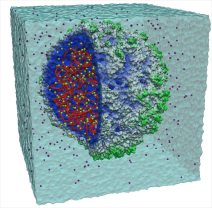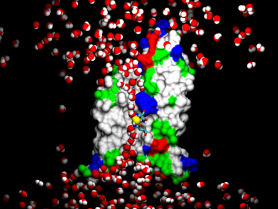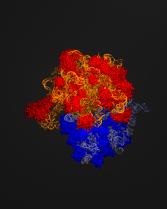Publication figure rendering with NVIDIA Gelato
Starting with version 1.8.6, VMD includes built-in support for the NVIDIA Gelato rendering system. One of the unique features of Gelato is its ability to use NVIDIA GPUs to accelerate the rendering process, while still supporting tremendous scene complexity and retaining the high output quality that professional software renderers are known for. A full list of Gelato features is available here.
In order to use Gelato with VMD, you will need to make sure that your system meets the Gelato requirements, and that you're using VMD 1.8.6 or later. Since VMD can export a molecular scene to the Gelato "PYG" Python based scene format, you can export the VMD scene to PYG even on an unsupported hardware configuration, and run Gelato manually to generate the output.
VMD 1.8.6 Gelato scene export notes and limitations:
- Several of the advanced features of Gelato such as ambient occlusion lighting, stereoscopic rendering, and programmable shading aren't automatically utilized yet, but will be supported in future versions VMD.
- Highly specular materials look slightly different in Gelato than in VMD, as VMD currently uses the built-in Gelato shaders which use a slightly different model for calculating specular highlights. Slighgtly decreasing the "shininess" parameter in VMD materials controls will produce the expected look in Gelato.
- VMD depth cueing parameters are not currently exported to the Gelato scene.
- VMD user-defined clipping planes are not currently exported to the Gelato scene.
- VMD volumetric texturing is not currently exported to the Gelato scene. Surfaces colored by potential maps will be colored light gray and will have no potential-based coloring applied.
Example VMD scenes rendered with Gelato
Satellite Tobacco Mosaic Virus
Ribosome







